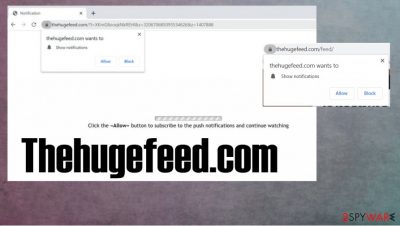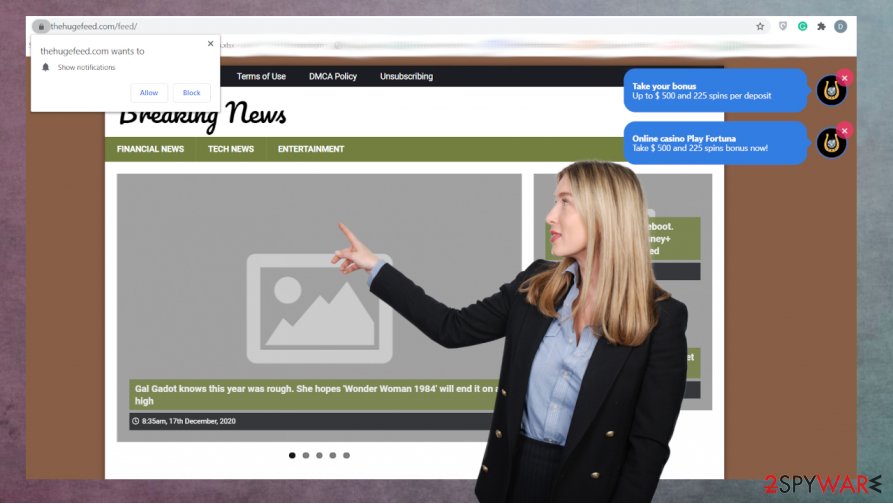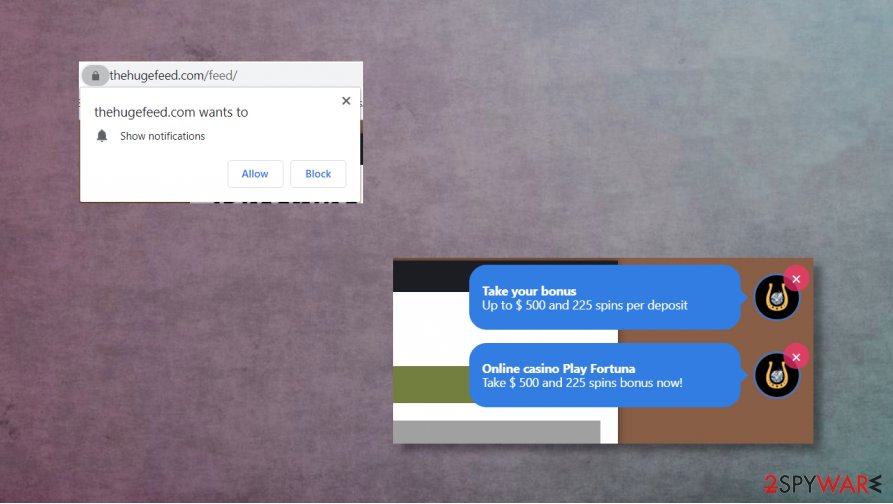Thehugefeed.com (Virus Removal Instructions) - Simple Removal Guide
Thehugefeed.com Removal Guide
What is Thehugefeed.com?
Thehugefeed.com – a website that triggers redirects to fake news sites and constantly shows intrusive ads

Thehugefeed.com is a rogue website that tricks people into allowing push notifications that send ads directly to desktops, even when the browsers are closed. As soon as such a site is visited, it tries to deceive its visitors into consenting to notifications to either see images of articles, continuing to watch a video, or similar.
Irrelative, mischievous ads are shown to visitors trying to trick them into clicking on them. These ads might suggest that the users won in a lottery, they have to claim an amazing discount or claim some incredible casino bonus. These ads have nothing to do with the site the users will be redirected to if they click on them.
| name | Thehugefeed.com |
|---|---|
| type | Rogue website, adware |
| Symptoms | Ads start appearing directly on the desktop. More than usual ads are seen while browsing |
| Risks | Deceptive ads could lead to malicious sites where the users might get tricked into installing PUPs or get infected with malware |
| Distribution | Ads start appearing when a user presses the Allow button for push notifications. Adware promoting this site might be installed with software bundles |
| Removal | Use our free Thehugefeed.com removal instructions at the bottom of this article. Scan your device with anti-malware tools to make sure no additional PUPs were installed |
| System health | Use the FortectIntego tool to refresh Windows and get your device back on track after dealing with adware |
As soon as unaware computer user agrees to get notifications from Thehugefeed.com, it starts to bombard its victims with various kinds of ads that pose as websites with adult content, gambling, and alike. Yet again, those ads have nothing in common with where the user will end-up if he clicks on them.
Websites that misuse the push notifications aren't an uncommon thing these days. Developers of such sites get revenue from the promotional sites where the users are redirected via the deceptive ads that, as mentioned before, have nothing to do with the content of presented ads. Most commonly, users get redirected to shopping or online gaming websites.
Furthermore, those ads will be shown not in a browser window but directly on the desktop. Please read our article and find out how to remove this adware from your device. Even though it is not a Thehugefeed.com virus, but the PUP that controls all the redirects can trigger more issues.
Here are a few examples of sites that deceive users into allowing push notifications in order to show tons of deceitful advertisements (by pressing on the websites, you can read our detailed guides about them):
If you were dipped into allowing push notifications from the culprit of this article, or you're unhappy with the content that it's promoting, you can remove Thehugefeed.com with our free guide posted below. It's quite easy, so you don't have to be a highly experienced computer user do it.

If you are being redirected to the fake news website but have never visited it, that might mean that your devices are infected with adware or a more advanced PUP. In that case, the Thehugefeed.com removal from the browser won't solve the problem. You will have to scan your computer with trustworthy anti-malware software like SpyHunter 5Combo Cleaner or Malwarebytes and fully eliminate the threat.
Experts[1] recommend scanning the entire computer system with system repair tools like the FortectIntego app to make sure that no core settings were modified and, if they were – restore them. Thehugefeed.com is related to various questionable sources and PUAs. System irregularities could result in an overall performance loss, crashing, and so on, so it's better to be safe than sorry.
Don't allow notifications from untrustworthy sites
When visiting websites for the first time, users should refrain from pressing the Allow button when a notification pops up, urging them to allow these push notifications. First, users should be certain that the sites are legitimate and won't bombard their devices with invasive ads.

Remember that no genuine, lawful website would ever ask you to allow push notifications in order to watch some video, download a file, view pictures, and so on. Only cybercriminals willing to promote some websites are using these kinds of social-engineering tricks.
As mentioned in the first chapter of this article, ads displayed by fake news websites might redirect its users to misleading or malicious sites, where potentially unwanted programs[2] (PUPs) might get installed, which might lead to devices being infected by severe malware.[3]
Remove Thehugefeed.com virus notifications and secure your device
If you encounter ads shown on your desktop and an abnormal amount of ads while your browsing, that could mean two things – either your device is infected with adware, or you (or someone else that uses your device) allowed push notification from Thehugefeed.com.
As we've pointed out earlier, the shown ads might lead to malicious sites, so it's unsafe to keep seeing them. You can manually remove Thehugefeed.com from all browser with our free guide provided below this article. If you keep getting redirected to various sites without your consent, scan your device with anti-malware tools because you will most likely have adware infestation.
When you've accomplished Thehugefeed.com removal, we highly recommend using system repair tools to locate and restore any system irregularities that might cause your devices to exhibit abnormal behavior, such as overheating, crashing, performance loss, etc.
You may remove virus damage with a help of FortectIntego. SpyHunter 5Combo Cleaner and Malwarebytes are recommended to detect potentially unwanted programs and viruses with all their files and registry entries that are related to them.
Getting rid of Thehugefeed.com. Follow these steps
Uninstall from Windows
Make sure to remove the main PUP that triggers issues with your device and causes all the Thehugefeed.com redirects
Instructions for Windows 10/8 machines:
- Enter Control Panel into Windows search box and hit Enter or click on the search result.
- Under Programs, select Uninstall a program.

- From the list, find the entry of the suspicious program.
- Right-click on the application and select Uninstall.
- If User Account Control shows up, click Yes.
- Wait till uninstallation process is complete and click OK.

If you are Windows 7/XP user, proceed with the following instructions:
- Click on Windows Start > Control Panel located on the right pane (if you are Windows XP user, click on Add/Remove Programs).
- In Control Panel, select Programs > Uninstall a program.

- Pick the unwanted application by clicking on it once.
- At the top, click Uninstall/Change.
- In the confirmation prompt, pick Yes.
- Click OK once the removal process is finished.
Delete from macOS
Remove items from Applications folder:
- From the menu bar, select Go > Applications.
- In the Applications folder, look for all related entries.
- Click on the app and drag it to Trash (or right-click and pick Move to Trash)

To fully remove an unwanted app, you need to access Application Support, LaunchAgents, and LaunchDaemons folders and delete relevant files:
- Select Go > Go to Folder.
- Enter /Library/Application Support and click Go or press Enter.
- In the Application Support folder, look for any dubious entries and then delete them.
- Now enter /Library/LaunchAgents and /Library/LaunchDaemons folders the same way and terminate all the related .plist files.

Remove from Microsoft Edge
Delete unwanted extensions from MS Edge:
- Select Menu (three horizontal dots at the top-right of the browser window) and pick Extensions.
- From the list, pick the extension and click on the Gear icon.
- Click on Uninstall at the bottom.

Clear cookies and other browser data:
- Click on the Menu (three horizontal dots at the top-right of the browser window) and select Privacy & security.
- Under Clear browsing data, pick Choose what to clear.
- Select everything (apart from passwords, although you might want to include Media licenses as well, if applicable) and click on Clear.

Restore new tab and homepage settings:
- Click the menu icon and choose Settings.
- Then find On startup section.
- Click Disable if you found any suspicious domain.
Reset MS Edge if the above steps did not work:
- Press on Ctrl + Shift + Esc to open Task Manager.
- Click on More details arrow at the bottom of the window.
- Select Details tab.
- Now scroll down and locate every entry with Microsoft Edge name in it. Right-click on each of them and select End Task to stop MS Edge from running.

If this solution failed to help you, you need to use an advanced Edge reset method. Note that you need to backup your data before proceeding.
- Find the following folder on your computer: C:\\Users\\%username%\\AppData\\Local\\Packages\\Microsoft.MicrosoftEdge_8wekyb3d8bbwe.
- Press Ctrl + A on your keyboard to select all folders.
- Right-click on them and pick Delete

- Now right-click on the Start button and pick Windows PowerShell (Admin).
- When the new window opens, copy and paste the following command, and then press Enter:
Get-AppXPackage -AllUsers -Name Microsoft.MicrosoftEdge | Foreach {Add-AppxPackage -DisableDevelopmentMode -Register “$($_.InstallLocation)\\AppXManifest.xml” -Verbose

Instructions for Chromium-based Edge
Delete extensions from MS Edge (Chromium):
- Open Edge and click select Settings > Extensions.
- Delete unwanted extensions by clicking Remove.

Clear cache and site data:
- Click on Menu and go to Settings.
- Select Privacy, search and services.
- Under Clear browsing data, pick Choose what to clear.
- Under Time range, pick All time.
- Select Clear now.

Reset Chromium-based MS Edge:
- Click on Menu and select Settings.
- On the left side, pick Reset settings.
- Select Restore settings to their default values.
- Confirm with Reset.

Remove from Mozilla Firefox (FF)
Remove dangerous extensions:
- Open Mozilla Firefox browser and click on the Menu (three horizontal lines at the top-right of the window).
- Select Add-ons.
- In here, select unwanted plugin and click Remove.

Reset the homepage:
- Click three horizontal lines at the top right corner to open the menu.
- Choose Options.
- Under Home options, enter your preferred site that will open every time you newly open the Mozilla Firefox.
Clear cookies and site data:
- Click Menu and pick Settings.
- Go to Privacy & Security section.
- Scroll down to locate Cookies and Site Data.
- Click on Clear Data…
- Select Cookies and Site Data, as well as Cached Web Content and press Clear.

Reset Mozilla Firefox
If clearing the browser as explained above did not help, reset Mozilla Firefox:
- Open Mozilla Firefox browser and click the Menu.
- Go to Help and then choose Troubleshooting Information.

- Under Give Firefox a tune up section, click on Refresh Firefox…
- Once the pop-up shows up, confirm the action by pressing on Refresh Firefox.

Remove from Google Chrome
Run the browser and reset it to avoid repetition of the infection
Delete malicious extensions from Google Chrome:
- Open Google Chrome, click on the Menu (three vertical dots at the top-right corner) and select More tools > Extensions.
- In the newly opened window, you will see all the installed extensions. Uninstall all the suspicious plugins that might be related to the unwanted program by clicking Remove.

Clear cache and web data from Chrome:
- Click on Menu and pick Settings.
- Under Privacy and security, select Clear browsing data.
- Select Browsing history, Cookies and other site data, as well as Cached images and files.
- Click Clear data.

Change your homepage:
- Click menu and choose Settings.
- Look for a suspicious site in the On startup section.
- Click on Open a specific or set of pages and click on three dots to find the Remove option.
Reset Google Chrome:
If the previous methods did not help you, reset Google Chrome to eliminate all the unwanted components:
- Click on Menu and select Settings.
- In the Settings, scroll down and click Advanced.
- Scroll down and locate Reset and clean up section.
- Now click Restore settings to their original defaults.
- Confirm with Reset settings.

Delete from Safari
Remove unwanted extensions from Safari:
- Click Safari > Preferences…
- In the new window, pick Extensions.
- Select the unwanted extension and select Uninstall.

Clear cookies and other website data from Safari:
- Click Safari > Clear History…
- From the drop-down menu under Clear, pick all history.
- Confirm with Clear History.

Reset Safari if the above-mentioned steps did not help you:
- Click Safari > Preferences…
- Go to Advanced tab.
- Tick the Show Develop menu in menu bar.
- From the menu bar, click Develop, and then select Empty Caches.

After uninstalling this potentially unwanted program (PUP) and fixing each of your web browsers, we recommend you to scan your PC system with a reputable anti-spyware. This will help you to get rid of Thehugefeed.com registry traces and will also identify related parasites or possible malware infections on your computer. For that you can use our top-rated malware remover: FortectIntego, SpyHunter 5Combo Cleaner or Malwarebytes.
How to prevent from getting adware
Access your website securely from any location
When you work on the domain, site, blog, or different project that requires constant management, content creation, or coding, you may need to connect to the server and content management service more often. The best solution for creating a tighter network could be a dedicated/fixed IP address.
If you make your IP address static and set to your device, you can connect to the CMS from any location and do not create any additional issues for the server or network manager that needs to monitor connections and activities. VPN software providers like Private Internet Access can help you with such settings and offer the option to control the online reputation and manage projects easily from any part of the world.
Recover files after data-affecting malware attacks
While much of the data can be accidentally deleted due to various reasons, malware is one of the main culprits that can cause loss of pictures, documents, videos, and other important files. More serious malware infections lead to significant data loss when your documents, system files, and images get encrypted. In particular, ransomware is is a type of malware that focuses on such functions, so your files become useless without an ability to access them.
Even though there is little to no possibility to recover after file-locking threats, some applications have features for data recovery in the system. In some cases, Data Recovery Pro can also help to recover at least some portion of your data after data-locking virus infection or general cyber infection.
- ^ Utanvirus. Utanvirus. Spyware and security news.
- ^ Potentially unwanted program. Wikipedia. The free encyclopedia.
- ^ John Love. Malware Types and Classifications. Lastline. American cyber security company and breach detection platform.























